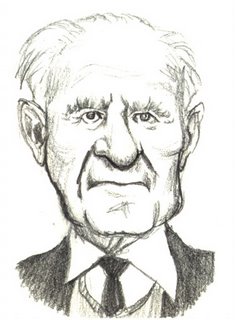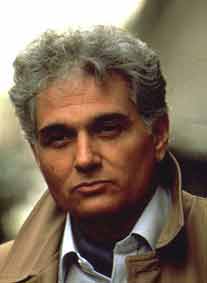 "Sometimes a male river eel is just a male river eel."
"Sometimes a male river eel is just a male river eel." -- Felix Blueblazes.
A loud war rages over Sigmund Freud and his legacy -- was he a scientist, or a fantasist? a healer or a charlatan? -- but the fact that no cease fire has emerged in the multiple decades since his death, nor any cozy nor cool detente been reached, indicates the staying power of his oeuvre. Freud's grip on us extends far beyond the realm of the academics, however, as Freudian concepts such as "anal-retentiveness" and "phallic symbol" have become easily absorbable constituents of the pop lexicon.
Born on this day in 1856 in Freiburg, Moravia, Freud was an exceptional student. He initially considered going into law or literary criticism -- both disciplines known for their interpretive manhandling of texts and utterances -- but instead turned his attention to natural science, entering the University of Vienna in 1873 and working with Brücke and Helmholtz. His earliest scientific paper was on male river eels (1877), but he later turned to human pathology, studying aphasia and infantile cerebral paralysis.
He graduated in 1881 and began a clinical research fellowship at Vienna General Hospital, where his research on the effects of cocaine prompted a colleague to embrace its use as a substitute for morphine in eye surgeries. In 1885, Freud went to Paris on scholarship and studied with the neuropathologist Jean Charcot, who was interested in the condition of "hysteria" -- then thought to be a nervous disorder linked to gynecological conditions and therefore afflicting only women. When he returned to Vienna, Freud presented a lecture on "male hysteria" which he claimed to have observed in Paris, but he was roundly humiliated by his colleagues for his outlandish view that such a thing could even exist.
At that point, Freud "withdrew from academic life and ceased to attend the learned societies," although as a practicing neuropathologist he would continue his research on nervous disorders. With Josef Breuer, he used hypnosis to treat "Anna O.," a young "hysteric." Their account of the experiment was published as
Studies in Hysteria (1895), and in it, they described a treatment method called "catharsis," in which a patient relives a traumatic event under hypnosis; they posited that the resulting emotional discharge could relieve the patient of certain types of neuropathological blindness or paralysis. Freud's fruitful partnership with Breuer fell apart, however, over Freud's insistence that neurotic symptoms were produced as a psychological defense against repressed unacceptable sexual fantasies and drives.
In the half decade following
Studies in Hysteria, Freud embarked on a "Project" to confirm this theoretical neurophysiological basis for psychology, aided by his exploratory correspondence with physician Wilhelm Fleiss as well as a period of intense "self-analysis" over ambivalent feelings toward his recently deceased father. On the therapeutic side, he abandoned hypnosis in favor of "free association," the provocation of stream-of-consciousness utterances from his patients that Freud believed provided a window on the unconscious mind.
From this period of isolation, although he failed to complete his "Project" successfully (he abandoned the desire to find observable, quantifiable biological causes for neuroses, although his methods would continue to have the buzz of biological determinism about them), at the age of 44 he emerged with the beginnings of a comprehensive theory of psychoanalysis, first in
The Interpretation of Dreams (1900), a philosophical memoir in which he theorized that dreams contained symbolic clues to unconscious conflicts -- initiating the kind of textual interpretation and search for meaning in what would otherwise be seen as casual phenomena that would inhabit his analytical approach for the rest of his life. He continued to define his new "science" in
The Psychology of Everyday Life (1904), in which Freud analyzed slips of the tongue (known today as "Freudian slips") and other mental "accidents" as further clues of inner conflict, and in
Three Essays on Sexuality (1905), in which he boldly contended that adult neurosis was generated by unconscious crises of childhood sexual identity, embodied in the "Oedipal complex," an unarticulated childhood desire for sexual validation from one's opposite-sex parent.
While his theories were denounced by the old guard of mind-scientists, they were compelling enough to win a host of youthful admirers, such as Alfred Adler, Carl Jung and Otto Rank. Although all 3 of these star pupils would eventually bitterly break away from Freud (Adler would downplay the relative importance of unconscious sex drives in favor of the conscious drive for self-betterment; Jung would subordinate Freud's sex drive analysis to a consideration of the higher calling of the "collective unconscious"; and Rank would move on over the autocratic style of psychoanalytic treatment methods), Freud's views would continue to hold sway over an army of psychoanalysts around the world; and history tends to show the essential influence of Freud's habits of interpretation on his ex-Freudians, evidencing the propagation of Freud's thought through the protesting theories of his critics and former followers. In short, his definition of a relationship between the unconscious mind and one's observable behavior changed everything.
From 1905 to the early 1920s, Freud published numerous elucidations and applications of his theories (including
Beyond the Pleasure Principle, 1920, in which he proposed eros, the life instinct, and thanatos, the death instinct, as the two principal, opposing and interlocking, motivating forces in humans) as he settled comfortably into the role of cigar-smoking, anecdote-telling Father of his own Movement. In 1923, coincident with being diagnosed with cancer of the jaw (launching 16 years of surgery, culminating in his jaw being replaced with a prosthesis), Freud further delineated his topography of the unconscious in
The Ego and the Id. In it, he detailed his influential theory of human personality, involving the clash of the "id" (the infantile, biological engine of pleasure) and the "superego" (the regulating conscience) on the battlefield of the "ego" (the conscious personality) -- resulting in a new definition of therapy as an attempt to mitigate the harshness of the superego.
With the rise of the Nazis, psychoanalysis was banned in Germany, and when Hitler invaded Austria in 1938, Freud fled and resettled in London, where he died on September 23, 1939.
Freud's hobby of turning his theories on the creators and objects of art and literature has been amply rewarded (or avenged) over the years: in works by D.M. Thomas (
The White Hotel), Irving Stone (
The Passions of the Mind), John Irving (
Hotel New Hampshire), Anthony Burgess (
The End of the World News: An Entertainment) and E.L. Doctorow (
Ragtime), Freud has taken a turn as protagonist or colorful cameo personality; and Freud himself has been portrayed in films by the likes of Montgomery Clift (
Freud, 1962), Alan Arkin (
The Seven-Per-Cent Solution, 1976) and Alec Guinness (
Lovesick, 1983), most often for cartoon effect, such is the pop cultural stickiness of his image and his interpretive constructs.
Labels: Freud, Philosophy, Pop Culture, Psychoanalysis, Psychology








